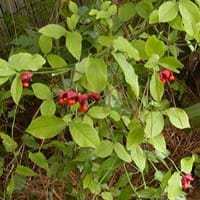Life Span
Perennial
Perennial
Origin
Eastern Asia
Northeastern United States, Mid-Atlantic United States, Southeastern United States, South-Central United States
Types
Actinidia arguta, Actinidia giraldii, Actinidia hypoleuca
Not Available
Number of Varieties
Not Available
Habitat
Dappled Shade, open Woodlands
Shady Edge, Woodland Garden Dappled Shade
USDA Hardiness Zone
3-8
6-8
Sunset Zone
1a, 1b, 2a, 2b, 3a, 3b, 4, 5, 6, 7, 8, 9, 14, 15, 16, 17, 18, 19, 20
3b, 4, 5, 6, 7, 8, 9, 14, 15, 16, 17
Habit
Vining/Climbing
Upright/Erect
Flower Color
White, Ivory
White, Ivory
Flower Color Modifier
Bicolor
Not Available
Fruit Color
Green, Yellow green
Magenta, Orange, Red
Leaf Color in Spring
Green, Dark Green
Green
Leaf Color in Summer
Dark Green
Green
Leaf Color in Fall
Dark Green
Yellow, Red, Burgundy
Leaf Color in Winter
Light Green
Not Available
Leaf Shape
Oval
Lance shaped
Plant Season
Spring, Summer, Fall
Fall, Winter
Sunlight
Full Sun, Partial Sun
Full Sun, Partial Sun, Partial shade, Full Shade
Growth Rate
Medium
Medium
Type of Soil
Loam
Clay, Loam
The pH of Soil
Neutral
Acidic, Neutral
Soil Drainage
Well drained
Well drained
Bloom Time
Spring, Late Spring, Early Summer
Early Summer
Tolerances
Shade areas
Drought
Where to Plant?
Ground, Pot
Ground, Pot
How to Plant?
Grafting, Stem Cutting
Seedlings, Semi-hardwood cuttings
Plant Maintenance
Low
Medium
Watering Requirements
Average Water Needs, Requires regular watering
Average Water Needs, Do Not over Water
In Summer
Regular watering required
Lots of watering
In Spring
Moderate
Moderate
In Winter
Average Water
Average Water
Soil pH
Neutral
Acidic, Neutral
Soil Type
Loam
Clay, Loam
Soil Drainage Capacity
Well drained
Well drained
Sun Exposure
Full Sun, Partial Sun
Full Sun, Partial Sun, Partial shade, Full Shade
Pruning
Remove damaged leaves, Remove dead branches, Remove dead leaves
Remove damaged leaves, Remove dead branches, Remove dead leaves
Fertilizers
Apply 10-10-10 amount, fertilize twice a year
All-Purpose Liquid Fertilizer
Pests and Diseases
Botrytis head rot, Japanese Beetles, Leaf Rollers, Nematodes, Phytophthora, Root rot, Sclerotinia blight, Spider mites, Thripes
Red blotch
Plant Tolerance
Shade areas
Drought
Flowers
Showy
Insignificant
Flower Petal Number
Single
Single
Foliage Texture
Medium
Medium
Foliage Sheen
Glossy
Matte
Attracts
Cats
Birds, Deers
Allergy
Not Available
Diarrhea, poisonous if ingested
Aesthetic Uses
Cottage Garden
Not Used For Aesthetic Purpose
Beauty Benefits
Not Available
Not Available
Environmental Uses
Shadow Tree
Air purification
Medicinal Uses
Antioxidants, Fiber, Folate, Rich in Potassium, Vitamin C
constipation, Liver problems, Malaria, Tonic
Part of Plant Used
Fruits
Bark, Root, Seeds
Other Uses
Grown for shade
The powdered bark is believed to eliminate dandruff, Used to make tea in cases of uterine prolapse, vomiting of blood
Used As Indoor Plant
No
No
Used As Outdoor Plant
Yes
Yes
Garden Design
Edible, Feature Plant, Vine
Mixed Border
Botanical Name
ACTINIDIA arguta
EUONYMUS americanus
Common Name
Hardy Kiwi
Strawberry bush, American strawberry bush, Bursting-heart
In Hindi
हार्डी कीवी
Strawberry Bush
In German
Hardy Kiwi
Strawberry Bush
In French
kiwai
Strawberry Bush
In Spanish
kiwi hardy
Fresa Bush
In Greek
σκληραγωγημένα ακτινίδια
φράουλα Μπους
In Portuguese
kiwi Hardy
Morango de Bush
In Polish
hardy kiwi
Strawberry Bush
In Latin
Hardy kiwi
Classic Bush
Phylum
Magnoliophyta
Magnoliophyta
Class
Magnoliopsida
Magnoliopsida
Order
Theales
Celastrales
Family
Actinidiaceae
Celastraceae
Clade
Angiosperms, Asterids, Eudicots
Angiosperms, Eudicots, Rosids
Tribe
Not Available
Not Available
Subfamily
Actinidiaceae
Celastroideae
Number of Species
Not Available
Not Available
Importance of Hardy Kiwi and Strawberry Bush
Want to have the most appropriate plant for your garden? You might want to know the importance of Hardy Kiwi and Strawberry Bush. Basically, these two plants vary in many aspects. Compare Hardy Kiwi and Strawberry Bush as they differ in many characteristics such as their life, care, benefits, facts, etc. Every gardener must at least have the slightest clue about the plants he wants to plant in his garden. Compare their benefits, which differ in many ways like facts and uses. The medicinal use of Hardy Kiwi is Antioxidants, Fiber, Folate, Rich in Potassium and Vitamin C whereas of Strawberry Bush is constipation, Liver problems, Malaria and Tonic. Hardy Kiwi has beauty benefits as follows: Not Available while Strawberry Bush has beauty benefits as follows: Not Available.
Compare Facts of Hardy Kiwi vs Strawberry Bush
How to choose the best garden plant for your garden depending upon its facts? Here garden plant comparison will help you to solve this query. Compare the facts of Hardy Kiwi vs Strawberry Bush and know which one to choose. As garden plants have benefits and other uses, allergy is also a major drawback of plants for some people. Allergic reactions of Hardy Kiwi are Not Available whereas of Strawberry Bush have Diarrhea and poisonous if ingested respectively. Having a fruit bearing plant in your garden can be a plus point of your garden. Hardy Kiwi has no showy fruits and Strawberry Bush has showy fruits. Also Hardy Kiwi is not flowering and Strawberry Bush is not flowering . You can compare Hardy Kiwi and Strawberry Bush facts and facts of other plants too.





